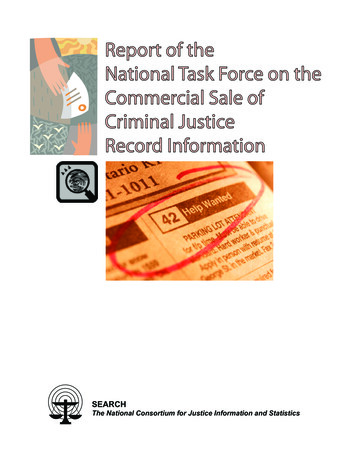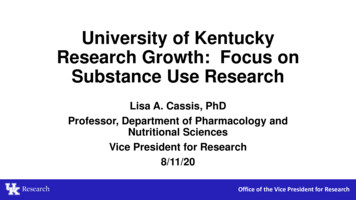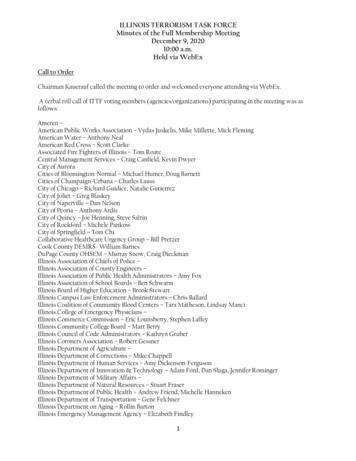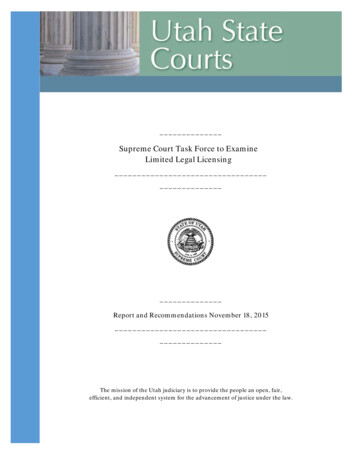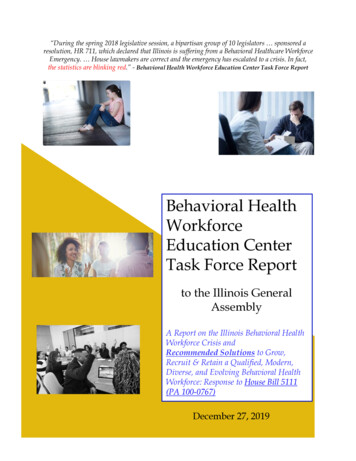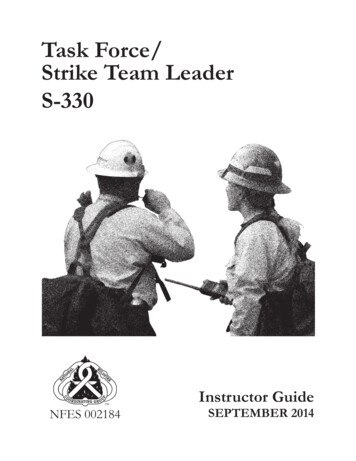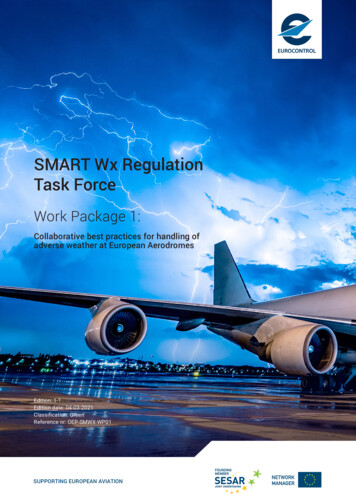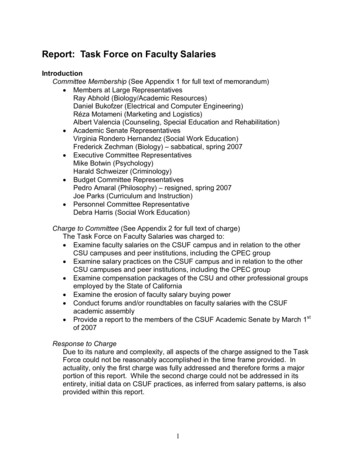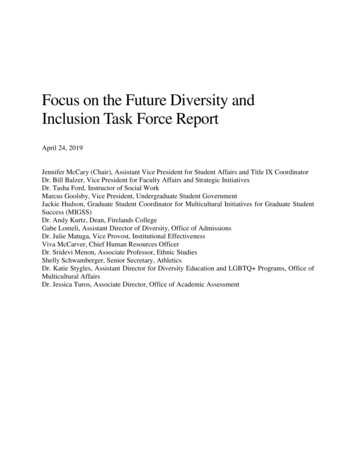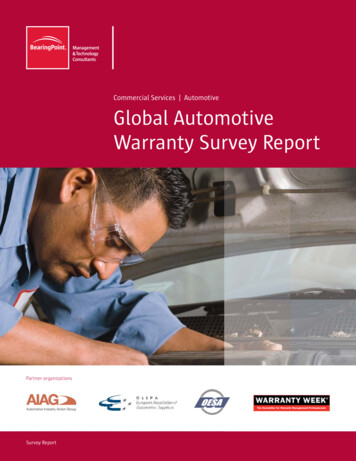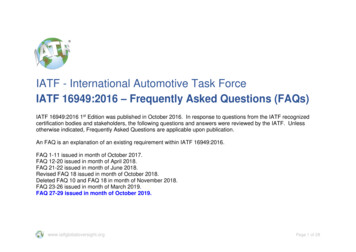
Transcription
IATF - International Automotive Task ForceIATF 16949:2016 – Frequently Asked Questions (FAQs)IATF 16949:2016 1st Edition was published in October 2016. In response to questions from the IATF recognizedcertification bodies and stakeholders, the following questions and answers were reviewed by the IATF. Unlessotherwise indicated, Frequently Asked Questions are applicable upon publication.An FAQ is an explanation of an existing requirement within IATF 16949:2016.FAQ 1-11 issued in month of October 2017.FAQ 12-20 issued in month of April 2018.FAQ 21-22 issued in month of June 2018.Revised FAQ 18 issued in month of October 2018.Deleted FAQ 10 and FAQ 18 in month of November 2018.FAQ 23-26 issued in month of March 2019.FAQ 27-29 issued in month of October 2019.www.iatfglobaloversight.orgPage 1 of 28
IATF - International Automotive Task ForceIATF 16949:2016 --- Frequently Asked Questions (FAQs)NUMBERIATF 16949REFERENCEQUESTIONS AND ANSWERSQUESTION:Why are there two manuals (IATF 16949:2016 and ISO 9001:2015)? Two manuals instead ofone manual makes it much more difficult to read and understand the requirements.ANSWER:1Foreword –Automotive QMSStandardThe IATF and ISO were not able to reach a licensing agreement to publish IATF 16949 in anintegrated document. In order to not further delay the launch of the new IATF 16949 standard, theIATF decided to publish in a two-manual format.Prior to release, the IATF did confirm with international accreditation organizations that otherindustry sectors use a two-manual format model to define their sector specific requirements, andauditing with the two-manual model, while not optimal, is effective.The IATF maintains strong cooperation with ISO by continuing the liaison committee statusensuring continued alignment with ISO 9001.QUESTION:Why are the two manuals (IATF 16949:2016 and ISO 9001:2015) so much more expensivethan the ISO/TS 16949 version?2Foreword –Automotive QMSStandardANSWER:Without the co-licensing agreement between ISO and the IATF for the integrated format of IATF16949, the IATF was not able to negotiate a discount for the ISO 9001:2015 standard.The IATF kept the price of the automotive specific content consistent with prior pricing.Essentially, the difference is the full list price to ISO for their publication of ISO 9001.www.iatfglobaloversight.orgPage 2 of 28
IATF - International Automotive Task ForceIATF 16949:2016 --- Frequently Asked Questions (FAQs)NUMBERIATF 16949REFERENCEQUESTIONS AND ANSWERSQUESTION:What should be done if translation errors are discovered in the IATF 16949 standard?3Foreword –Automotive QMSStandardANSWER:The IATF uses a defined process for managing translations of the standard, including “crosschecking” the translation to ensure accuracy. If an organization, or a certification body, identifieswhat is believed to be a translation error, they should contact either the IATF member industryassociation or the Oversight Office supporting their certification body.QUESTION:What is the scope of this clause? Many organizations focus on regulatory/statutoryrequirements of the product and do not believe they have product safety relatedmanufacturing product or processes.44.4.1.2Product safetyANSWER:This clause focuses on product and manufacturing process characteristics that affect the safetyperformance of the final assembly. These characteristics may not be directly addressed inregulatory/statutory requirements, but may be defined by the customer.www.iatfglobaloversight.orgPage 3 of 28
IATF - International Automotive Task ForceIATF 16949:2016 --- Frequently Asked Questions (FAQs)NUMBERIATF 16949REFERENCEQUESTIONS AND ANSWERSQUESTION:55.3.1Organizational roles,responsibilities, andauthorities —supplementalIs the intent that responsibilities be assigned to the function (e.g. Quality), a specific title (e.g.Quality Director) or a named individual (e.g. Bob Smith)?ANSWER:Responsibilities are assigned to the role/position (i.e. specific title, Quality Director) within theorganization. Although individuals may have those responsibilities in their roles, theresponsibilities remain with the role (e.g. Quality Director). Therefore, top management will assignthe responsibility and authority to the role, not to the individuals by name.QUESTION:Are MSA studies required for each instrument or device?67.1.5.1.1ANSWER:Measurement systemNo. A complete statistical study on each single piece of equipment is not required.analysisInstruments with the same characteristics (e.g. measurement range, resolution, repeatability,etc.) can be grouped and a sample instrument (representative of the gauge family) can beused for the statistical study.www.iatfglobaloversight.orgPage 4 of 28
IATF - International Automotive Task ForceIATF 16949:2016 --- Frequently Asked Questions (FAQs)NUMBERIATF 16949REFERENCEQUESTIONS AND ANSWERSQUESTION 1:When can the equipment manufacturer be used to calibrate inspection and test equipment?If an accredited laboratory exists but is very remote and/or expensive and the inspection ortest equipment manufacturer is nearby and available can they be used (even if they are notaccredited to ISO/IEC 17025)?ANSWER 1:77.1.5.3.2External laboratoryThe inspection or test equipment manufacturer developed the methodology to maintain and adjustthe equipment to meet calibration requirements as part of the design and manufacture of theinspection or test equipment. Therefore, the original equipment manufacturer of the inspectionand test equipment is qualified to calibrate the equipment they designed and manufactured.The organization shall obtain customer approval before using any original equipment manufacturerfor calibration services.QUESTION 2:If the organization has inspection, measuring and test equipment in the final assembly andtest area, is it considered an internal laboratory?ANSWER 2:No. In-line measurement and test equipment used in any part of the manufacturing process orassembly process is not considered to be an internal laboratory.www.iatfglobaloversight.orgPage 5 of 28
IATF - International Automotive Task ForceIATF 16949:2016 --- Frequently Asked Questions (FAQs)NUMBERIATF 16949REFERENCEQUESTIONS AND ANSWERSQUESTION:Does the document (which could be a table, list or a matrix) have to include non-IATFOEMs and Tier 1s? Do all customer requirements beyond CSR’s need to be included inthe document?ANSWER:The organization is responsible for evaluating customer requirements, including customerspecific requirements, and including them in the scope of the organization’s qualitymanagement system, per IATF 16949, Section 4.3.2.87.5.1.1Quality managementsystemdocumentationA document (which could be a table, a list or a matrix) is required as part of the qualitymanual, per IATF 16949, Section 7.5.1.1 d). The document shall include all direct customersof the certified organization, which may include IATF OEMs, non-IATF OEMs, and otherautomotive customers (i.e. tier-1, tier-2, etc.).For example, a tier-2 organization must consider the customer requirements, includingcustomer-specific requirements, of all its customers. The Tier-2 organization does notneed to consider the customer requirements of the automotive OEM if the OEM is notits direct customer.It is important to note that the non-IATF OEM customers and other automotive customers mayhave customer requirements in an internal document that is shared with their suppliers (e.g.such as a supplier quality manual) or in a specific document available to the public (e.g.internet).www.iatfglobaloversight.orgPage 6 of 28
IATF - International Automotive Task ForceIATF 16949:2016 --- Frequently Asked Questions (FAQs)NUMBER8(cont.)IATF 16949REFERENCE7.5.1.1Quality managementsystemdocumentationQUESTIONS AND ANSWERSIdentifying customer-specific requirements may be difficult if the non-IATF OEM or otherautomotive customers do not clearly link to IATF 16949 clauses in their customer requirementdocuments. A way to identify if any customer-specific requirements exist is to compare sectionsof the IATF 16949 standard where the term « if required by the customer » exists and verify ifthe existing customer requirement document lists any specific requirements that are related toa requirement in the IATF 16949 standard. If yes, that customer and their requirements shouldbe added to the document (which could be a table, a list or a matrix) in the quality manual.Organizations are not expected to take the customer’s requirements, including customerspecific requirements, and convert them into a CSR format that aligns with the IATF 16949clauses similar to what has been published by the IATF OEMs.8.4.2.2Statutory andregulatoryrequirementsQUESTION 1:What is the perspective (on statutory and regulatory conformity)? What is consideredsufficient evidence of conformity to applicable statutory and regulatory requirements (8.6.5)?ANSWER 1:9and8.6.5Statutory As defined in 8.3.3.1 g) and 8.3.4.2, the organization is required to have an approach to research,identify, obtain copies of, review, understand, and assure compliance with the statutory andregulatory requirements for the product they are manufacturing in the country where they aremanufacturing products and the destination country where they are shipping the products to.Page 7 of 28
IATF - International Automotive Task ForceIATF 16949:2016 --- Frequently Asked Questions (FAQs)NUMBERIATF 16949REFERENCE8.4.2.2Statutory andregulatoryrequirements (cont.)9(cont.)and8.6.5Statutory andregulatoryconformity (cont.)QUESTIONS AND ANSWERSThe intent of 8.4.2.2 is that the organization designs into their product developmentmethodology/business process(es) and their supplier management methodologies/businessprocess(es), one or more approaches for obtaining confirmation and evidence from their suppliersthat the products and services being provided by the supplier comply with the statutory andregulatory requirements of the country where the supplier is manufacturing them, the country wherethe organization is using them, and the country where the organization ships their product to, ifprovided by the customer.The intent of 8.6.5 is to require the organization to check the records of conformance/compliancereceived from the supplier to assure that the lot code, batch number, or comparable traceabilityinformation for the product are covered by the evidence provided by the supplier. This could be doneupon receipt from the supplier, or while the product is in inventory, but must be done prior to releaseof the product into the organization’s production flow.QUESTION 2:Did the intent of clause 8.4.2.2 change from ISO/TS 16949 to IATF 16949?ANSWER 2:The intent of the clause did not change. The ISO/TS 16949 requirement was “All purchased productshall conform to applicable statutory and regulatory requirements”. In this “passive voice” wording,the IATF decided their expectations were not clear. The new requirement is more explicit about whatis to be done, when it is to be done, and what evidence is required to support compliance.www.iatfglobaloversight.orgPage 8 of 28
IATF - International Automotive Task ForceIATF 16949:2016 --- Frequently Asked Questions (FAQs)NUMBERIATF 16949REFERENCEQUESTIONS AND ANSWERSQUESTION 3:How do you manage and maintain current knowledge of statutory and regulatoryrequirements for international suppliers?8.4.2.2Statutory andregulatoryrequirements (cont.)9(cont.)and8.6.5Statutory andregulatoryconformity (cont.)ANSWER 3:IATF 16949, section 8.6.5, does not require the organization to be aware of or keep a list of all theinternational statutory and regulatory requirements for the externally provided processes, productsor services they purchase.The organization is required to review the results of, audit, or otherwise periodically verify, that thesupplier’s process is robust and assures compliance with the latest applicable statutory, regulatoryand other requirements in the countries where they are manufactured and in the customer-identifiedcountries of designation.QUESTION 4:How can our system comprehend the statutory and regulatory requirements if they are notcommunicated to the organization by the customer?ANSWER 4:The clause as worded expects the customer to provide information to the organization of where theproducts are going to be shipped. Changes to the applicable statutory and regulatory requirementsdue to changes in these destinations are only a requirement to the organization “if provided” by thecustomer.www.iatfglobaloversight.orgPage 9 of 28
IATF - International Automotive Task ForceIATF 16949:2016 --- Frequently Asked Questions (FAQs)NUMBER10deletedIATF 16949REFERENCE8.4.2.3.1Automotive productrelated software orautomotive productswith embeddedsoftwareQUESTIONS AND ANSWERSSee SI 15, issued November 2018, effective January 2019.QUESTION 1:What is the intent and requirements for “rendering unusable” prior to disposal? When andwhere does the “rendering unusable” of product need to occur?118.7.1.7Nonconformingproduct dispositionANSWER 1:The intent is to ensure that the product cannot find its way into the unofficial aftermarket, onto a roadvehicle, or accidentally shipped to the customer.The process of rendering nonconforming product unusable, does not have to occur in themanufacturing area as long as the product is rendered unusable prior to final disposal.www.iatfglobaloversight.orgPage 10 of 28
IATF - International Automotive Task ForceIATF 16949:2016 --- Frequently Asked Questions (FAQs)NUMBERIATF 16949REFERENCEQUESTIONS AND ANSWERSQUESTION 2:How does the organization control this?11(cont.)ANSWER 2:8.7.1.7Nonconformingproduct dispositionThe organization is responsible to develop and implement a nonconforming product dispositionprocess and verify its effectiveness.QUESTION 3:Can the organization use a service provider to render the product unusable?ANSWER 3:Yes, it is acceptable to contract the process of rendering the product unusable to a service provider.If a service provider is used, the organization needs to approve, and periodically verify, how thesupplier is rendering the product unusable.www.iatfglobaloversight.orgPage 11 of 28
IATF - International Automotive Task ForceIATF 16949:2016 --- Frequently Asked Questions (FAQs)NUMBERIATF 16949REFERENCEQUESTIONS AND ANSWERSQUESTION 4:Does nonconforming product disposition apply only to final product or does it also apply tocomponent/interim sub-assembly?ANSWER 4:11(cont.)8.7.1.7Nonconformingproduct dispositionThis requirement applies to the product that has gone through the part approval process and thatthe organization is shipping to the customer.QUESTION 5:For rendering unusable, how much damage needs to be done to the nonconforming product?ANSWER 5:The nonconforming product needs to be rendered unusable and unrepairable. There is norequirement for crushing or pulverizing the product into many pieces.QUESTION:Is it acceptable to document multiple processes in one “documented process”? Or do theyeach have to be individual documented processes?12Throughout the IATF16949 Standardwww.iatfglobaloversight.orgANSWER:Yes, it is acceptable for an organization to group multiple documented processes into one (or more)processes. Each documented process does not have to be a standalone process. Organizationsshould document their processes as it makes sense to their individual business and organizationalneeds.Page 12 of 28
IATF - International Automotive Task ForceIATF 16949:2016 --- Frequently Asked Questions (FAQs)NUMBERIATF 16949REFERENCEQUESTIONS AND ANSWERSQUESTION:What are the requirements regarding the levels of training and the particular criteria requiredto be identified in relation to product safety (4.4.1.2)?ANSWER:134.4.1.2Product safetyAs with all personnel competency requirements, the people assigned to specific tasks need to becompetent for that task. That competence needs to include the rules and regulations associatedwith the task.The safety requirements in 4.4.1.2 are very specific as to what is required. The sections include,referring to IATF 16949 section 4.4.1.2:a) suppliers are expected to be aware of all statutory and regulatory requirements associated withthe markets for use of the parts, as identified by the customer. The supplier needs to know whereto research the regulations for all affected countries or regions.b) Customer specifics will identify any customer notification requirements; therefore, knowledge incustomer specifics (which may be taught by an internal designated subject matter expert).c) The special approvals for design FMEAs would be identified in customer specifics, see item b)above.d) and e) The identification of product safety related characteristics and their controls would bedefined by the customer in its definition of special characteristics and required controls. Thepersonnel developing PFMEAs and Control Plans would need to be knowledgeable in those areasof their customer(s) documents.www.iatfglobaloversight.orgPage 13 of 28
IATF - International Automotive Task ForceIATF 16949:2016 --- Frequently Asked Questions (FAQs)NUMBERIATF 16949REFERENCEQUESTIONS AND ANSWERSEach line item f) through m) can also be similarly analyzed to determine the level of training andsource of that training for each requirement within the safety requirements.13(cont.)4.4.1.2Product safetySince many of the requirements depend upon customer specific requirements, there is no singlecomplete industry training on this topic. The organization needs to review the customer andregulatory requirements associated with each of its parts appropriate for the intended country ofuse and safety-related part characteristics.Some customers may have specific requirements regarding product safety, training, knowledge,and personnel. It is the organization’s responsibility to understand their customer’s specificrequirements related to product safety.QUESTION:Is it required that the calibration certificate or (test) report of an external laboratory bears themark (or logo or symbol) of the relevant national accreditation body that accredited thelaboratory to ISO/IEC 17025?147.1.5.3.2External laboratoryANSWER:Yes, only certificates of calibration or test reports including the mark of a national accreditation bodyare acceptable.The accreditation mark (often also called “accreditation logo” or “accreditation symbol”) of a nationalaccreditation body provides documented evidence that the provided inspection, test, or calibrationservices were performed according to the accreditation scope and that they comply with therequirements of ISO/IEC 17025, and are subject to supervision of a national accreditation body.www.iatfglobaloversight.orgPage 14 of 28
IATF - International Automotive Task ForceIATF 16949:2016 --- Frequently Asked Questions (FAQs)NUMBERIATF 16949REFERENCEQUESTIONS AND ANSWERSQUESTION:What is the acceptable method to assess a supplier’s software development capability?ANSWER:158.3.2.3Development ofproducts withembedded softwareThe intent of IATF 16949, Section 8.3.2.3 is to apply the same level of rigor to the development ofsoftware as is expected in the development of hardware parts. Just like parts, software hasdefined performance, operating conditions, known inputs, specified outputs, parameters ofenvironment (e.g. size of the file), regulatory requirements (if any), known failure modes, usageprofiles, variability of conditions of operation, etc.The planning, designing, writing, testing, confirming and production validation phases in thedevelopment of software are not very different in concept from the development of hardware parts.IATF 16949 provides a robust framework to validate that all necessary steps have been taken todesign, verify, and produce hardware parts that continue to meet specification in mass production.While similar in concept, those steps are not the same for the development of software. Therefore,a different set of criteria are used to evaluate the methods used to develop software.Those criteria are not included in IATF 16949; therefore, other methods are referred to, such asAutomotive SPICE and CMMI. There may be other acceptable methods available identified bysome customers. Each customer may have a preferred tool to assess supplier softwaredevelopment capability. The organization should ask their customer(s) to confirm the acceptableassessment tool. Each customer may also specify a different approach used (e.g., customer onsite assessment, supplier self-assessment, or a combination of both).The role of the IATF 16949 internal or external auditor is not to have the knowledge to conduct theAutomotive SPICE or CMMI assessments. However, the internal or external auditor should befamiliar enough with the assessments to be able to recognize when a software assessmentrequirement has not been met and that there are corrective action plans in place, with thewww.iatfglobaloversight.orgPage 15 of 28
IATF - International Automotive Task ForceIATF 16949:2016 --- Frequently Asked Questions (FAQs)NUMBERIATF 16949REFERENCE15(cont.)8.3.2.3Development ofproducts withembedded softwareQUESTIONS AND ANSWERSappropriate resources assigned. The IATF 16949 internal and external auditor should also know ifthe customer participates in that software development assessment and how that is documented.QUESTION:If there is low risk with an organization’s supplier(s), are 2nd party audits required? Whatis the intent?168.4.2.4.1Second-party auditsANSWER:The risk-based thinking approach, driven by ISO 9001:2015, needs to be incorporated for suppliermanagement. The risk analysis needs to be completed and depending on the results of the riskassessment (see below), then a 2nd party audit may not be required.To support the risk analysis, the organization needs to consider criteria such as: supplier certificationstatus, commodity complexity, new product launch(es), significant employee turn-over, productquality issues, delivery issues, customer specific requirements, and other risks to the organizationor to their customer(s).www.iatfglobaloversight.orgPage 16 of 28
IATF - International Automotive Task ForceIATF 16949:2016 --- Frequently Asked Questions (FAQs)NUMBERIATF 16949REFERENCEQUESTIONS AND ANSWERSQUESTION:Does there have to be an alternative process control for each primary control specified in thecontrol plan?ANSWER:No, it is not a requirement to have an alternative process control for every primary control.17When introducing new products, an organization should consider the risk of the primary controlpotentially failing and, based on risk and severity of failure mode, decide where alternative processcontrols are needed. When back-up or alternate process controls are needed, then both theprimary and alternative process controls should be defined in the process flow, PFMEA, controlplan, and the standardized work available.8.5.6.1.1Temporary change ofprocess controlsFor existing processes, where there is a failure in the primary process control, and no alternativeprocess control is defined, the organization should consider risk, (e.g. FMEA) and if approved,develop standardized work for an alternative process control, implement the controls, verifyeffectiveness through daily management, and then revalidate when the primary control is restored.Periodically, the organization shall review instances of where alternative process controls havebeen used and consider this as an input to update the process flow, FMEA, and control plan.(See SI 11)www.iatfglobaloversight.orgPage 17 of 28
IATF - International Automotive Task ForceIATF 16949:2016 --- Frequently Asked Questions (FAQs)NUMBER18deletedIATF 16949REFERENCEQuality managementsystem audit9.2.2.2QUESTIONS AND ANSWERSSee SI 14, issued November 2018, effective January 2019.QUESTION:For each manufacturing process audit do all shifts have to be covered?199.2.2.3Manufacturingprocess auditANSWER:Each audit does not have to cover all shifts in one audit (for example an audit of the pressingprocess could be done on shift 1 and 2, sampling shift changeover in year 1, and then in year 2 or3 an audit undertaken on the third shift for pressing). However, all manufacturing processes mustbe audited on all shifts over a three-year cycle, the frequency depending on risk, performance,changes etc.QUESTION:Why is there no defined audit frequency for Product audit?209.2.2.4Product auditANSWER:The audit frequency must be determined based on the risk and product complexity (See ISO 9001,Section 9.2.2). If an organization has high risk and high product complexity, it is recommended thatproduct audit frequency be increased.www.iatfglobaloversight.orgPage 18 of 28
IATF - International Automotive Task ForceIATF 16949:2016 --- Frequently Asked Questions (FAQs)NUMBERIATF 16949REFERENCEQUESTIONS AND ANSWERSQUESTION:Is a layout inspection different from a product requalification or functional testing?ANSWER:Yes, as stated in Note 1 of 8.6.2 of IATF 16949, [Layout inspection is the complete measurement of allproduct dimensions shown on the design record(s)]; layout inspection is limited to dimensionalmeasurement and requirements. Performance or materials measurements are not included in a layoutinspection.218.6.2Layout inspectionand functionaltestingProduct requalification would normally imply full validation to all product approval requirements (e.g.PPAP or PPA) and therefore exceeds the scope of a layout inspection.Functional testing/verification would normally be limited to performance and material measurementssuch as durability or tensile strength and would not include dimensional measurements.Where frequency is not defined by the customer, the organization is responsible to define the frequencyof layout inspection.Layout inspection is a part of product requalification, if product requalification is required by thecustomer.On-going layout inspection and functional testing requirements are defined in the control plan. Ifcustomer-specific requirements exist, then those requirements (including layout inspection and functionaltesting requirements) are also included in the control plan.www.iatfglobaloversight.orgPage 19 of 28
IATF - International Automotive Task ForceIATF 16949:2016 --- Frequently Asked Questions (FAQs)NUMBERIATF 16949REFERENCEQUESTIONS AND ANSWERSQUESTION:How does a product audit differ from a layout inspection?ANSWER:As defined in section 3 of IATF 16949, the term product is used to represent “ any intendedoutput ” of the manufacturing process.229.2.2.4Product auditProducts typically have dimensional, performance (functional) and material requirements,therefore, product audits may contain verification of dimensional, performance (functional), ormaterial requirements. As stated in the FAQ 21 above, a layout inspection is limited todimensional requirements.Product audits can be carried out on finished or partially finished product, following customerspecified approaches (e.g. VDA 6.5 Product Audit), if applicable. Product audits may includepackaging and labelling requirements.A product audit, like other audit types, is an independent verification of compliance torequirements. As such, the product audit has a defined frequency and scope specified withinthe audit programme and is based on risk.www.iatfglobaloversight.orgPage 20 of 28
IATF - International Automotive Task ForceIATF 16949:2016 --- Frequently Asked Questions (FAQs)NUMBERIATF 16949REFERENCEQUESTIONS AND ANSWERSQUESTION:238.5.1.3Verification of jobset-upsIf first-off/last-off part validation is not performed or appropriate for a specific type ofmanufacturing process, are such records to be maintained per 8.5.1.3 e)?ANSWER:As stated in 8.5.1.3 d), first-off/last-off part validation is performed only when it is applicable andappropriate. Where the validation is not performed because it is not applicable or appropriate,there is no requirement to maintain records.QUESTION 1:If the organization is not responsible for product design and is therefore only manufacturingproducts as per the customer s design, is the organization then exempt from therequirements in 8.4.2.2?ANSWER 1:248.4.2.2Statutory rgNo, all organizations regardless of their responsibility for product design must satisfy theapplicable requirements of 8.4.2.2. The applicable requirements address purchased products,processes, and services for which the organization is responsible.Page 21 of 28
IATF - International Automotive Task ForceIATF 16949:2016 --- Frequently Asked Questions (FAQs)NUMBERIATF 16949REFERENCEQUESTIONS AND ANSWERSQUESTION 2:Is the organization required to request a complete list of countries of destination from thecustomer if the list was not provided by the customer?ANSWER 2:Yes, the organization is required to request a complete list of the countries of destination from thecustomer if the list was not provided by the customer.NOTE:o24(cont.)8.4.2.2Statutory andregulatoryrequirements(cont.)ooThe “country of receipt” is where the organization is located.(Country of the manufacturing site)The “country of shipment” is the customer’s receiving location.(Country where the manufacturing site ships to)The “country of destination” is the country where the vehicle is sold.(Country where the final product is initially sold)QUESTION 3:What is the consequence if the customer does not provide the information on the countriesof destination to the organization? What is the organization required to document in thissituation?ANSWER 3:If the organization claims that the customer did not provide the necessary information on thecountries of destination, the organization should be able to produce written evidence (e.g. letters,emails, meeting minutes, etc.) of their efforts to obtain it.www.iatfglobaloversight.orgPage 22 of 28
IATF - International Automotive Task ForceIATF 16949:2016 --- Frequently Asked Questions (F
than the ISO/TS 16949 version? ANSWER: Without the co-licensing agreement between ISO and the IATF for the integrated format of IATF 16949, the IATF was not able to negotiate a discount for the ISO 9001:2015 standard. The IATF kept the price of the a
